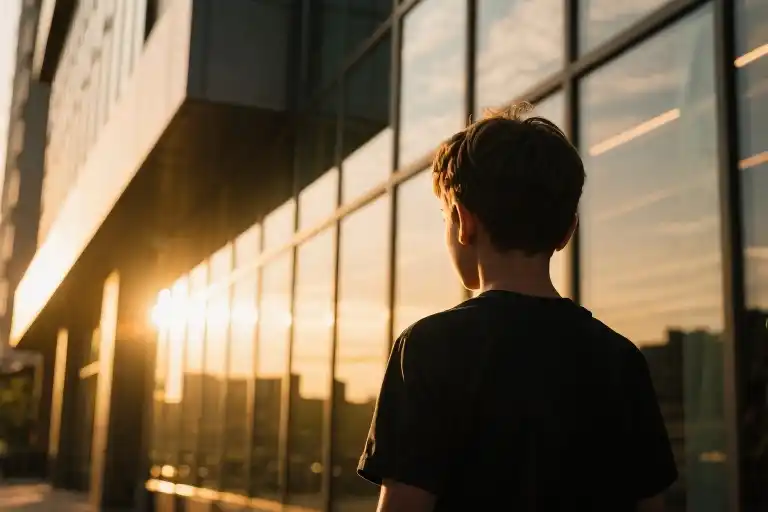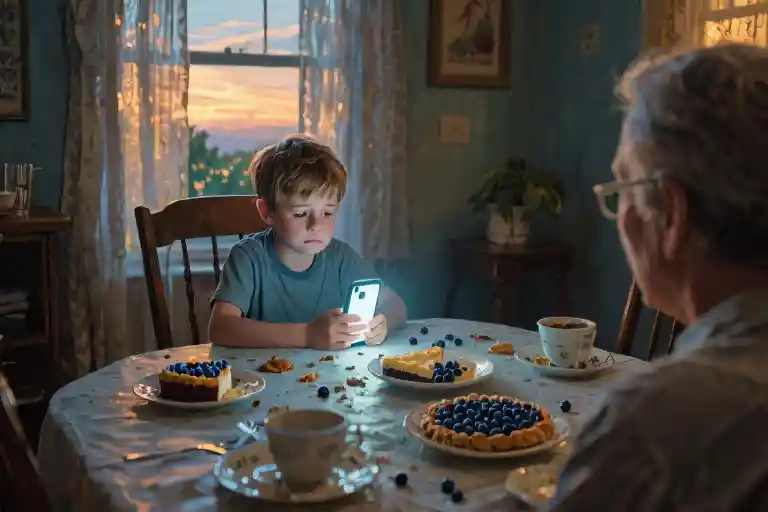The notification popped up just as I was basking in the glow of 300 Instagram likes. Angela’s DM should have been just another drop in the social media dopamine drip—another stranger complimenting what I’d proudly captioned “Proud dad moment at Summit One Vanderbilt.” But something about the way she asked, “Is your son available for modeling?” made my thumb freeze mid-scroll.
That photo had felt like a minor miracle when I took it. Golden hour light fractured through the observation deck’s geometric glass, casting prismatic patterns across Charlie’s face as he struck that effortlessly cool pose only teenagers can manage. My iPhone camera roll is normally filled with blurry candids and poorly framed group shots, but this? This looked like something out of a J.Crew catalog.
Charlie had actually smiled—not the sarcastic smirk he perfected at thirteen, but a genuine, if slightly embarrassed, grin when I begged him to stand near the glass for “just one shot.” Maybe it was the altitude, or the way the Manhattan skyline stretched behind him like a living postcard. For once, he didn’t complain about me playing photographer dad.
The likes started accumulating before we even descended the elevator. First from relatives, then Charlie’s friends (who never engage with my posts), then complete strangers. By the time we grabbed dinner in Midtown, my lock screen kept lighting up with heart notifications. “Guess you’re viral now,” Charlie mumbled through a bite of burger, but I caught him sneaking peeks at the comments.
That’s when Angela’s message arrived. Her profile showed a woman in her thirties surrounded by half-finished oil paintings, her bio simply reading “Artist seeking muses.” Innocent enough—until I noticed she’d liked every single photo of Charlie from the past two years, including school play shots with twelve total likes. My thumb hovered over the block button as she sent a second message: “His bone structure is perfect for my new series.”
In that moment, I realized something unsettling. What began as an ordinary attempt to capture family memories had turned into something I couldn’t control. The same social media platforms that let me share proud parenting moments also made my child discoverable in ways I’d never considered. That perfect photo still lives on my phone, but now it’s tucked behind three privacy settings—a compromise between preserving the memory and protecting what matters most.
The Accidental Masterpiece
Summit One Vanderbilt isn’t just another observation deck – it’s New York’s latest temple to social media validation. The geometric glass panels create endless reflections, turning every visitor into both photographer and subject in an infinite hall of mirrors. That afternoon, the golden hour light transformed the space into something out of a sci-fi film, with sunbeams slicing through the glass at impossible angles.
My teenage son Charlie normally recoils at parental photography attempts like a vampire from garlic. But something about that environment – maybe the Instagram-ready lighting, maybe the crowd of influencers striking poses – made him drop his defenses. He leaned against one of those triangular glass panels with a casual confidence that made me fumble for my iPhone. No fancy equipment, just the battered phone case that’s survived three years of parenting chaos.
The technical aspects were all wrong by professional standards. I didn’t adjust the exposure compensation. The HDR mode was purely accidental. Yet through some alchemy of afternoon light and adolescent nonchalance, the image looked like it belonged in a high-end travel magazine. Charlie’s silhouette against the Manhattan skyline, the sun catching the edges of his untamed hair, the way his half-smile suggested he knew something the viewer didn’t – it was the kind of moment professional photographers wait hours to capture. I got it by sheer dumb luck during the thirty seconds my teenager tolerated being my subject.
What fascinates me now isn’t the photographic technicalities, but how the environment shaped the moment. Summit One’s design practically begs for social media content – every angle curated for maximum shareability. Even Charlie, normally allergic to parental attention, recognized he was standing in a natural spotlight. The glass walls reflected not just our images, but this unspoken understanding that some moments demand documentation. We’d entered a space where resisting the camera felt more unnatural than posing.
That’s the strange magic of smartphone photography today. The barriers between observer and participant have dissolved. You don’t need to understand aperture settings when the environment does half the work for you. The real skill lies in recognizing those fleeting moments when light, subject, and setting conspire to create something extraordinary – then having the presence of mind to raise your phone before the spell breaks.
Of course, I didn’t think about any of this when I tapped ‘share.’ In that moment, it was just another proud dad moment, amplified by likes and heart-eye emojis. The photo’s technical imperfections – the slightly blown-out highlights, the imperfect framing – only made it feel more authentically mine. Professional photographers might cringe at my process, but that image captured something no perfectly composed shot could: the beautiful accident of an ordinary moment transformed.
The Like Storm
The notification chime became my soundtrack for the next quarter hour. Ding. Ding-ding. Ding. My lock screen lit up like a slot machine hitting jackpot – Megan liked your photo, David commented: “Charlie looks so grown up!”, Your post has been shared 12 times. I clutched my iPhone like a lottery ticket, thumb swiping compulsively to refresh the analytics.
Our family group chat exploded in parallel. My sister-in-law sent seven crying-laughing emojis followed by “Since when does Charlie pose??”. My mother replied with her signature all-caps: “MY GRANDSON THE MODEL!” Beneath the pixelated enthusiasm, I recognized that quiet parental triumph – capturing a teenage boy’s unguarded joy between eye rolls.
Then came the follower spike. Twenty-three new faces in the ‘Followers’ tab, mostly artfully blurred profile pictures with handles like @CreativeSoulStudio or @VisionaryCanvas. I nearly missed Angela’s sunflower-yellow icon between the flood of generic avatars. Her like registered at the 47-minute mark – late enough to seem deliberate, early enough to appear organic.
Something about her double-tap felt heavier than the others. Maybe it was the way her comment nested under my caption (“Golden hour magic at Summit One!”): “The geometry of light here is transcendent. Your son has an incredible aura – have you considered professional portraits?” Polite. Flattering. The kind of message you’d typically smile at and forget.
Except her profile showed no family portraits, no vacation snaps – just angular abstract paintings where faces might have been. And when I clicked her tagged photos, every single post featured different children posing beside her canvases.
The DM That Changed Everything
The notification popped up just as I was showing Charlie the latest likes on his photo. A direct message from someone named Angela, with a single heart-eyed emoji. Nothing alarming at first glance – just another social media interaction in the sea of notifications. But something about the timing felt off, arriving nearly two hours after the initial posting frenzy had died down.
Her profile picture showed a woman in her late thirties surrounded by half-finished canvases, the kind of artsy aesthetic that usually signals a harmless creative type. Yet the paintings themselves gave me pause – mostly portraits of teenagers, all with similar features to Charlie. Same angular jawline, same way of tilting their heads. Coincidence, probably. But when I clicked through her gallery, every single post featured young men in their late teens, all tagged with locations across Manhattan.
Charlie barely glanced up from his phone when I mentioned it. ‘Dad, you get weird followers all the time. It’s just how Instagram works.’ He had a point – my own modest following included a suspicious number of ‘fitness models’ and crypto enthusiasts. But this felt different. Angela’s comments on my photo were oddly specific (‘The light catches his cheekbones just like my nephew’s’) and her follow-up messages increasingly personal (‘Does he always stand with his weight on one leg like that?’).
What unsettled me most was the mismatch between her artistic persona and actual behavior. Real artists I’ve known talk about composition and technique. Angela only commented on Charlie’s physical attributes. Her supposed art studio, visible in the background of some posts, lacked the usual clutter of real creative spaces – no paint splatters, no stacked canvases. Just suspiciously clean surfaces and carefully arranged brushes.
I did what any paranoid parent would do – checked her followers list. Mostly private accounts with stock photo profile pictures, a few with the same artistic aesthetic as hers. No mutual connections, no comments from real people on her posts. The whole profile had that slightly-too-perfect quality of something constructed rather than grown organically.
Charlie’s reaction was typical teenage dismissal. ‘So she’s weird. Block her and move on.’ But the way he shifted uncomfortably when I pointed out how many local teens she’d photographed told me he wasn’t as unconcerned as he pretended. We’d entered that strange modern parenting moment where you have to decide how much to push without triggering total shutdown.
That night, after Charlie went to bed, I did some digging. Reverse image searches on her paintings led nowhere. The studio address listed in her bio didn’t exist. And the handful of comments on her posts all used suspiciously similar phrasing. The whole account felt like a stage set – convincing at first glance, but hollow when you looked closer.
I thought about all the times I’d casually posted photos of Charlie over the years – first days of school, soccer games, beach vacations. How many other Angelas might have been watching? The photo that started it all still glowed on my phone screen, suddenly looking less like a proud parenting moment and more like an identity theft risk waiting to happen.
Social media safety talks with teens are tricky. Come on too strong and you sound paranoid; too casual and they tune out. I settled for showing Charlie how to check an account’s authenticity – look at post history consistency, check for tagged locations that match the bio, see if followers engage meaningfully. Basic digital literacy stuff that somehow never came up in our previous ‘online safety’ conversations.
What stayed with me wasn’t just the creep factor of Angela’s messages, but how easily I’d dismissed my initial unease. That perfect photo had blinded me to the risks of oversharing. The likes and comments created such a pleasant dopamine rush that I’d ignored basic parental instincts. Charlie might roll his eyes at my ‘overreaction,’ but I noticed he’d set his own account to private the next morning without me asking.
The Conversation Behind the Lens
The glow from Charlie’s phone screen illuminated his face as I hovered in his bedroom doorway. That viral photo – the one strangers were now complimenting with alarming familiarity – still glowed on his Instagram profile. He barely glanced up when I cleared my throat.
“We need to talk about Angela,” I said, perching on the edge of his gaming chair. The vinyl squeaked under my weight, a sound that used to make him giggle when he was small. Now it just earned me an eye roll.
“She’s just some art lady,” Charlie muttered, fingers still dancing across his screen. “Her profile’s got, like, five thousand followers.”
I took his phone, ignoring his protest. Up close, Angela’s paintings had an unsettling quality – beautiful landscapes with one distorted element, like a tree growing upside down from a cloud. Her latest comment on Charlie’s photo read: “The jawline of a young Greek god. Would love to sketch you sometime.”
“Creepy, right?” I prompted.
Charlie shrugged. “She’s probably just trying to get more followers. Everyone does that.”
His nonchalance startled me. At fourteen, my son understood TikTok algorithms better than I ever would, yet couldn’t spot the red flags in a stranger’s fixation on his “jawline.” We spent the next hour dissecting Angela’s profile – the disproportionate number of teenage boy followers, the paintings that increasingly focused on adolescent subjects, the way her compliments always circled back to meeting in person.
“But I’d never actually go somewhere with her,” Charlie finally conceded, scratching at a pimple on his chin. The gesture made him look painfully young. “I’m not stupid, Dad.”
We compromised on new family rules:
- All social posts delayed by 24 hours for “cooling off” review
- Location tags permanently disabled
- Stranger DMs automatically screened through my account
Charlie groaned about the restrictions, but didn’t fight me when I helped him adjust his privacy settings. As I clicked through menus, I noticed his camera roll – hundreds of nearly identical selfies, each minutely adjusted for lighting and angle. This was his generation’s photo album, curated not for family memories, but for maximum social validation.
“You know,” I said as I handed back his phone, “your grandpa still keeps our childhood photos in shoeboxes under his bed.”
Charlie smirked. “That’s because he’s old.”
Later, watching him sleep with one arm flung over his eyes like a little kid, I wondered if we’d struck the right balance. The internet had given Charlie a confidence I never had at his age – that effortless way he’d posed against the Manhattan skyline. But it also demanded he package himself for public consumption before he’d fully figured out who he was.
The next morning, we deleted the Vanderbilt photo from all public accounts. The composition remained perfect, the lighting still magical. Only now, its audience shrunk from thousands to two – a father and son who finally understood that some moments lose their meaning when shared with strangers.
Redefining Perfection
The moment I tapped ‘Delete’ on that viral photo felt like closing a door I hadn’t realized was left open. There was no dramatic soundtrack, no sudden realization – just the quiet understanding that some moments are too precious to be measured in likes. That photo of Charlie now lives exclusively in our family’s physical album, tucked between his middle school graduation and our disastrous attempt at baking sourdough during lockdown.
What surprised me wasn’t the withdrawal from public validation (though I’ll admit checking my notifications less frequently), but how the photo transformed when removed from its digital context. Without the pressure of performing for invisible audiences, we began noticing different details – the way Charlie’s left shoelace was untied, how his shadow merged with the geometric patterns of the observation deck, the unguarded smile he reserved only for family. My iPhone camera, which I’d always considered merely adequate, had somehow preserved these truths despite my amateur skills.
This shift made me reconsider why we photograph at all. Professional photographers talk about ISO and rule of thirds, but for parents, the magic happens when technical limitations collide with emotional truth. That slightly blurred edge where Charlie moved too fast? Proof of his restless energy. The overexposed patch where sunlight hit the glass? Exactly how radiant the moment felt. These ‘flaws’ became the photo’s real signature.
The safety checklist we developed might surprise digital natives:
- The 24-hour rule: Never post in the moment. Let emotions settle.
- Background audit: Zoom in on every pixel for accidental personal data.
- Consent conversations: Even with teens, discuss each shareable image.
- Alternate angles: Keep the best versions just for family.
- Regular digital detox: Archive old posts monthly.
What began as a privacy scare became an unexpected gift in how we document family life. Charlie and I now have weekly ‘photo walks’ where we challenge each other to capture mundane beauty – no filters, no posting, just seeing. Last week’s winner was his shot of our elderly neighbor’s hands pruning roses, sunlight catching the web of veins beneath paper-thin skin. It would never go viral, and that’s precisely why it’s perfect.
There’s an intimacy to images spared from algorithms, a quiet rebellion against the performative perfection of social media. The photos we take now might have poorer lighting and clumsier composition, but they contain something the original viral shot never could – the freedom of existing solely for us.
The Photo That Found Its Right Place
The album sits on our living room shelf now, its leather cover slightly worn at the edges from frequent handling. Page 37 holds that particular photograph – no filters, no hashtags, no strangers’ comments threading below it. Just Charlie caught in that golden light, forever fifteen and suspended in a moment that almost became something else entirely.
There’s an unexpected peace in this physical form of preservation. The glossy paper surface reflects lamplight differently than a phone screen ever could. When visitors flip through the album and pause at that page, their fingers leave faint smudges that I’ve learned not to mind. These marks become part of the photograph’s history, unlike digital fingerprints that vanish with each refresh.
Charlie sometimes pulls the album down himself, usually when friends come over. I’ll catch him showing them the sequence from our Vanderbilt adventure – the goofy outtakes before the perfect shot, the way the cityscape framed his silhouette. His narration always includes the Angela incident now, delivered with dramatic flair that makes everyone lean in. What began as a privacy scare has transformed into our family’s modern cautionary tale, complete with his own embellishments about ‘that creepy art lady’.
We’ve developed rituals around these physical copies. Every December, we print that year’s best family photos to add to the album. Charlie insists on writing captions in his terrible handwriting, complete with inside jokes that will probably baffle us in a decade. His younger sister has started drawing borders around certain pictures, her crayon flowers and stars creeping into the margins.
That original viral-worthy photo looks different to me now. Not because the image has changed, but because its context has deepened. The glass panels behind Charlie no longer represent just a trendy observation deck, but the fragile transparency we navigated as a family. The golden hour light reminds me less of perfect lighting conditions and more of how close we came to letting a beautiful moment be hijacked.
Occasionally, when I pass by the shelf, I’ll open to page 37 and remember how many forms a photograph can take. It was a social media post, then a warning sign, then a conversation starter, and finally – most importantly – simply our picture. The album closes with a soft thump, keeping its contents safe in that sweet spot between private memory and shared story, right where family photos belong.





